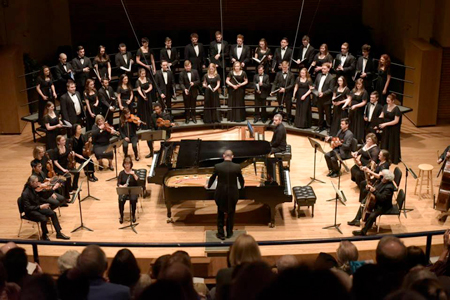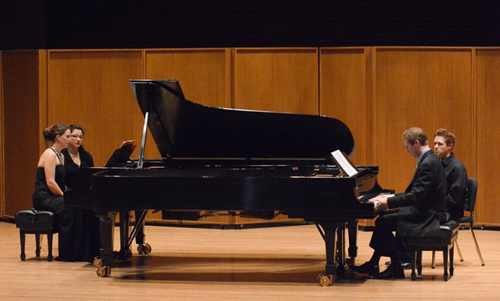by Daniel Hathaway

In order to explore Bach’s influence on Brahms, the Baldwin Wallace Bach Festival took a road less traveled by this year. Interrupting its normal performance cycle of Bach’s four major choral works, the Festival gave BW students a crack at Brahms’s A German Requiem. Additionally, festival director Dirk Garner invited the Westhuizen Duo to serve as guest artists, playing works for two pianos.
The all-Bach opening event on Friday evening, April 7 in Gamble Auditorium took on the feel of a musical smorgasbord with innovative stage management. The Third Brandenburg Concerto, a movement from the motet Singet den Herrn, two items from the Cantata BWV 21, and the Double Keyboard Concerto in c-minor were interleaved with solos: harpsichordist Nicole Keller played the Prelude in c-minor, BWV 921, and pianist Zarina Melik-Stepanova performed a piano transcription of the a-minor Organ Fugue, BWV 543.
Wandering the aisles, violinist Olivier Brault launched the evening with a movement from the E-Major Partita, and played other Partita movements during stage resets, which were managed by platoons of performers who efficiently moved chairs, stands, harpsichord, and pianos. This was a savvy way of nudging the concert along — an idea that by extension could neatly have eliminated the intermission.
The performances by Brault, Keller, Melik-Stepanova, the Festival Chamber Orchestra, and the BW Motet Choir — led by Dirk Garner — were assured and often brilliant. The Choir sang with enthusiasm, crisp diction, and fine attention to blend, especially in the motet. Oboist Danna Sundet and Brault deftly intertwined solos in the Cantata Sinfonia, and Pierre and Sophié Westhuizen joined in elegantly inflected performances of Bach’s complicated counterpoint in the double keyboard concerto.

Unable to attend in person, I followed Saturday evening’s performance of the Brahms German Requiem via the live stream. Octavio Más-Arocas conducted the BW Symphony Orchestra and the BW Festival Choir, prepared by Dirk Garner. The professional soloists were soprano Sherezade Panthaki and baritone Joshua Hopkins.
While it isn’t the same as being there, the streaming option is a terrific way for BW’s distant — or even nearby — fans to experience performances remotely. Perhaps one day soon, canny engineers will be able to sync sound precisely to video.
Among the many appealing innovations in BW’s Bach Festival under its new management: the start time for evening programs has been moved up to 7:00 pm. You can actually attend an evening concert and still dine at a reasonable hour afterward. Bravo to that!
Published on ClevelandClassical.com April 11, 2017.
Click here for a printable copy of this article



